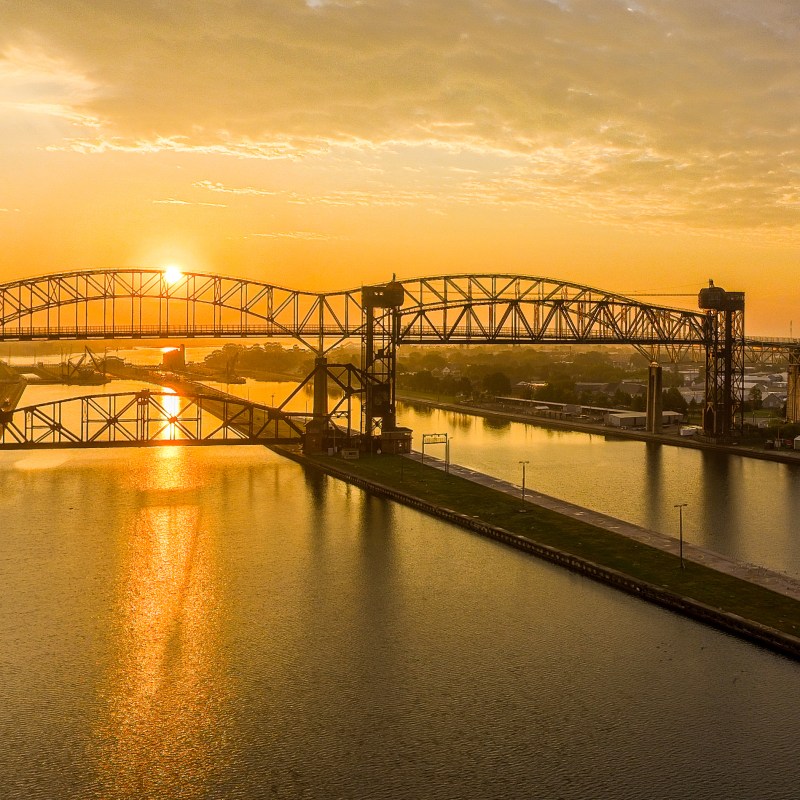
Sault Ste. Marie (pronounced Soo Saint Marie and known locally as “The Soo”) is a small city in northern Ontario, Canada, that’s a familiar stop for cross-Canada road-trippers, RVers, and campers. But it’s a gateway to so much more. Here you’ll find museums that are unlike anything else in the world and some of the best scenery in all of Canada. And the food is far from ordinary!
Videos by TravelAwaits
Here are eight excellent reasons to visit Sault Ste. Marie on your next getaway.
1. It’s Home To One Of Canada’s Most Scenic Train Rides
The Agawa Canyon Tour Train is one of Canada’s most scenic train rides, especially during the autumn when fall colors are at their brightest. Traveling 114 miles north of Sault Ste. Marie, the train takes sightseers along lakes, rivers, rock formations, canyon walls, and scenic vistas. These are the same landscapes that inspired the Group of Seven artists, and the views from the train are “classic Canadiana.”
The train stops at the bottom of the Agawa Canyon, its turn around point, and guests are encouraged to get out and explore for 90 minutes. There are opportunities to walk to waterfalls or climb some 300 feet to the scenic lookout point before making the return voyage. To help you have the most enjoyable trip, there is a small cafe on board, and guests have the option of bringing along their own picnics to enjoy in the canyon.
2. You Can Pay Tribute To The First Canadian Woman In Space
Dr. Roberta Bondar was Canada’s first female astronaut, as well as the first neurologist in space, and she grew up in Sault Ste. Marie. The city pays tribute to her accomplishments with the Roberta Bondar Park, pavilion, and marina, all located in the city center. The park and pavilion host a constantly changing roster of public events and festivities throughout the year, including Art in the Park, Canada Day, the Algoma Farmers Market, and the Bon Soo Winter Carnival (one of the largest winter festivals in Canada).
A bust and plaque honoring Bondar’s work is located within the park, and visitors can see these while exploring the park and the waterfront boardwalk, a popular walking and jogging spot.

3. You Can Visit The Only Bushplane Museum In The World
The Canadian Bushplane Heritage Centre pays homage to the humble bushplane, as well as the history of using planes in fire fighting. Housed in the original home of the Ontario Provincial Air Service — which first started experimenting with dropping water on forest fires in the mid-1940s — the museum exhibits trace the history of bushplanes in Canada, the role they played in forest fire protection, and how they helped develop the northern part of the country. In addition to water bombing, bushplanes were used for forest patrol, parachute drops, aerial photography, environmental monitoring, transportation, and cargo delivery.
The Bushplane Heritage Centre invites visitors to get hands-on with this history by taking a seat in the pilot’s chair and climbing into the cargo holds. On site, there’s also a special exhibit honoring women in aviation, including Roberta Bondar’s work.
4. There’s A Little-Known Collection Of Group Of Seven Artwork
The only public art gallery between Sudbury and Thunder Bay, Sault Ste. Marie’s most prominent gallery, the Art Gallery of Algoma focuses on Canadian and regional art. For a small gallery, it has a surprising collection of art from members of the Group of Seven, including Franklin Carmichael, A. Y. Jackson, J. E. H. MacDonald, and A. J. Casson, who found inspiration in local scenery of the surrounding countryside. While there, be sure to seek out the gallery’s collection of nature photography by Roberta Bondar. The gift shop also features products made by local artists, and there’s a nice cafe on site, too.

5. You Can Traverse The World’s Largest Waterway Traffic System — And Two Countries
If you want to experience a different side of Sault Ste. Marie, the best way to do so is to first head to the other Sault Ste. Marie — the one across the water in Michigan! Yes, there are two Sault Ste. Maries, in two different countries, separated by one waterway. On a tour of the Sault Ste. Marie Locks, known as the Soo Locks, you’ll set sail from Michigan. You’ll be on the world’s largest waterway traffic system, cruising alongside massive freighters. The Soo Locks sit at the northern end of the St. Marys River, connecting Lake Superior and Lake Huron.
The Locks make it possible for boats to traverse the 21-foot difference between the upper river and the lower river better known as the St. Marys Rapids. The trip includes cruising under the International Bridge, where you enter Canadian waters and see the Sault Ste. Marie, Ontario, cityscape. Themed tours are also available, allowing guests to take in the local lighthouses or enjoy the sights during a dinner cruise. On the Ontario side, guests can also visit the Canadian locks and marina, part of a Canadian National Historic Site, and enjoy hiking and biking.
6. The Local Cuisine Is Known As “Sault Italian”
What exactly is Sault Italian? The short answer is that it’s a variation of Italian cuisine unlike anything else you’ll find in Canada — or Italy! The long answer is that Italians immigrated to Sault Ste. Marie in record numbers after World War II, when the Italian economy was in tatters but Sault Ste. Marie was experiencing a post-war manufacturing boom with ample jobs at Algoma Steel. As a result, a distinct cuisine developed, with local produce rounding out the rustic recipes from 1940s Italy.
Those traditions survive to this day and Sault Ste. Marie is a paradise for fans of Italian food. You’ll find old-fashioned Italian breads, plenty of pasta dishes with ladles of red sauce, thin-crust pizzas Naples style, plus some local creations like deep-fried ravs — that’s deep-fried ravioli served with a marinara sauce for dipping. One thing you won’t find much of are chain restaurants, especially pizza joints or Italian-American brand names. Independent restaurants and cafes thrive here.
7. History Beckons At A Unique National Historic Site
Ermatinger Clergue National Historic Site is a historic site and museum. While it’s often referred to as the “old house” in Sault Ste. Marie, it’s actually three buildings: Ermatinger Old Stone House, the Clergue Blockhouse, and the Heritage Discovery Centre. The first two, the Ermatinger Old Stone House and the Clergue Blockhouse, are believed to be two of the oldest buildings in Canada west of Toronto. The Discovery Center, by contrast, is only a few years old.
Once the private family home of a prominent fur trader, the property has been at the heart of Sault Ste. Marie’s affairs for nearly 200 years. It has served as a mission, a hotel, a tavern, a courthouse, a post office, a dance hall, a tea room, and even an apartment building. In the summertime, in particular, Ermatinger is once again at the center of city life, with a full program of special events for visitors. The staff and the property get rave reviews from visitors for their hospitality and interpretive programs.
8. It’s The Gateway To The Legends Of Lake Superior
Sault Ste. Marie is situated beside the world’s largest freshwater lake, Lake Superior, home to legends, myths, and history equal to its tremendous size. A drive north from Sault Ste. Marie to Lake Superior Provincial Park is a beautiful scenic route and the park is equally lovely. Artifacts belonging to Indigenous people found here date to 500 B.C. You can see further evidence of their culture and communities in spring and summer, for when the water is calm, you can walk to see the Agawa Rock Pictographs. This is one of only a few pictograph sites in Ontario that is accessible on foot, and 35 red ochre images are visible. While in the park, guests can enjoy excellent fishing, hiking, paddling, and camping and learn about Lake Superior’s sad history of shipwrecks. The fabled ship the SS Edmund Fitzgerald sank just 15 nautical miles from the park, by Whitefish Bay.
Here’s where to see petroglyphs in the United States, plus nine reasons to visit Canada’s gorgeous Lake Louise.
